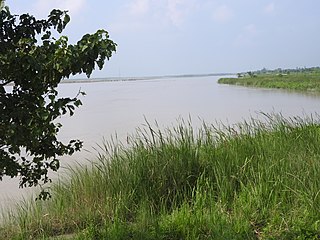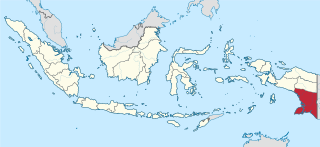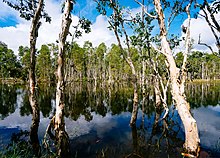
The Mamberamo is the second-longest river on the island of New Guinea, after Sepik River and the second largest in Oceania by discharge volume after Fly. It is located in the Indonesian province of Papua. It is the second largest river in Indonesia by volume of discharge after Kapuas and also the widest.

Western New Guinea, also known as Papua, Indonesian New Guinea, and Indonesian Papua, is the western half of the island of New Guinea, formerly Dutch and granted to Indonesia in 1962. Given the island is alternatively named Papua, the region is also called West Papua.

Western Province is a coastal province in southwestern Papua New Guinea, bordering the Indonesian provinces of Highland Papua and South Papua. The provincial capital is Daru. The largest town in the province is Tabubil. Other major settlements are Kiunga, Ningerum, Olsobip and Balimo.

The Koshi Tappu Wildlife Reserve is a protected area in the Terai of eastern Nepal covering 176 km2 (68 sq mi) of wetlands in the Sunsari, Saptari and Udayapur Districts. It comprises extensive reed beds and freshwater marshes in the floodplain of the Kosi River, and ranges in elevation from 75 to 81 m. It was established in 1976 and designated as a Ramsar site in December 1987. It hosts Nepal's last remaining herd of the wild water buffalo.

The Terai–Duar savanna and grasslands is a narrow lowland ecoregion at the base of the Himalayas, about 25 km (16 mi) wide, and a continuation of the Indo-Gangetic Plain in India, Nepal and Bhutan. It is colloquially called Terai in the Ganges Basin east to Nepal, then Dooars in West Bengal, Bhutan and Assam east to the Brahmaputra River. It harbours the world's tallest grasslands, which are the most threatened and rare worldwide.

The bronze quoll is a species of quoll found only in the Trans-Fly savanna and grasslands of Papua New Guinea and South Papua in Indonesia.
The Maro River also known as Sungai Merauke and Merauke-rivier, Merauki River flows in Merauke Regency, Papua, Indonesia. It is located just to the west of the Bensbach River of Western Province, Papua New Guinea.

The wildlife of Ivory Coast consists of the flora and fauna of this nation in West Africa. The country has a long Atlantic coastline on the Gulf of Guinea and a range of habitat types. Once covered in tropical rainforest, much of this habitat has been cleared, the remaining terrain being gallery forests and savanna with scattered groups of trees, resulting in a decrease in biodiversity. As of 2016, 252 species of mammal had been recorded in Ivory Coast, 666 species of bird, 153 species of reptile, 80 species of amphibian, 671 species of fish and 3660 species of vascular plant.

The wildlife of the Gambia is dictated by several habitat zones over the Gambia's land area of about 10,000 km2. It is bound in the south by the savanna and on the north by the Sudanian woodlands. The habitats host abundant indigenous plants and animals, in addition to migrant species and newly planted species. They vary widely and consist of the marine system, coastal zone, estuary with mangrove vegetation coupled with Banto Faros, river banks with brackish and fresh water zones, swamps covered with forests and many wetlands.

Rawa Aopa Watumohai National Park is a national park on the Indonesian island of Sulawesi, in the province of South East Sulawesi. It was declared in 1989 and has an area of 1,050 km². The park ranges from sea level to an altitude of 981 m. It contains the Aopa peat swamp, the largest in Sulawesi, and is recognised as a wetland of international importance.

The wildlife of Togo is composed of the flora and fauna of Togo, a country in West Africa. Despite its small size the country has a diversity of habitats; there are only remnants of the once more extensive rain forests in the south, there is Sudanian savanna in the north-western part of the country and larger areas of Guinean forest–savanna mosaic in the centre and north-east. The climate is tropical with distinct wet and dry seasons. There are estimated to be over 3000 species of vascular plants in the country, and 196 species of mammals and 676 species of birds have been recorded there.
Assagny National Park or Azagny National Park is a national park in the south of Ivory Coast. It is situated on the coast some 75 km (47 mi) to the west of Abidjan, between the mouth of the Bandama River and the Ébrié Lagoon, and occupies an area of about 17,000 hectares.

New Guinea is the world's second-largest island, with an area of 785,753 km2 (303,381 sq mi). Located in Melanesia in the southwestern Pacific Ocean, the island is separated from Australia by the 150-kilometre wide Torres Strait, though both landmasses lie on the same continental shelf, and were united during episodes of low sea level in the Pleistocene glaciations as the combined landmass of Sahul. Numerous smaller islands are located to the west and east. The island's name was given by Spanish explorer Yñigo Ortiz de Retez during his maritime expedition of 1545 due to the resemblance of the indigenous peoples of the island to those in the African region of Guinea.

The Trans Fly savanna and grasslands are a lowland ecoregion on the south coast of the island of New Guinea in both the Indonesian and Papua New Guinean sides of the island. With their monsoon and dry season climate these grasslands are quite different from the tropical rainforest that covers most of the island and resemble the landscape of northern Australia which lies to the south.

The Tonda Wildlife Management Area is a wetland of international importance and the largest protected area in Papua New Guinea. It is located in the south-western corner of the Western Province and is contiguous with Wasur National Park of Indonesia. It forms part of the Trans Fly savanna and grasslands ecoregion.

Morori is a moribund Papuan language of the Kolopom branch of the Trans–New Guinea family. It is separated from the other Kolopom languages by the intrusive Marind family. All speakers use Papuan Malay or Indonesian as L2, and many know Marind.

South Papua, officially the South Papua Province, is an Indonesian province located in the southern portion of Papua, following the borders of the Papuan customary region of Anim Ha. Formally established on 11 November 2022 and including the four most southern regencies that were previously part of the province of Papua and before 11 December 2002 had comprised a larger Merauke Regency, it covers a land area of 129,715.02 km2, about the same area as Pennsylvania. This area had a population of 513,617 at the 2020 Census, while the official estimate as at mid 2023 was 537,973, making it the least populous province in Indonesia.
The Bensbach River is a river in southwestern Papua New Guinea. It is located just to the east of the Maro River in Merauke Regency, Indonesia, and just to the west of the Morehead River in Papua New Guinea.
The Morehead River is a river in southwestern Papua New Guinea. It is located just to the east of the Bensbach River, and to the west of the Fly River. The river flows through the Trans-Fly savanna and grasslands.

Kanum people (Kanume) are an ethnic group that inhabits the border area of Merauke Regency in South Papua and Papua New Guinea. The Kanum is considered a subgroup of the Marind, but they have their own language which is the Kanum language that belongs to the Yam language family. This language is closer to the Yei language and other tribes in Papua New Guinea than to the Marind language, which is spoken by the largest ethnic group in Merauke.


















